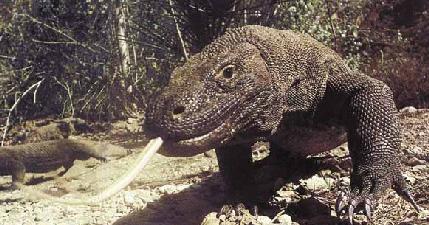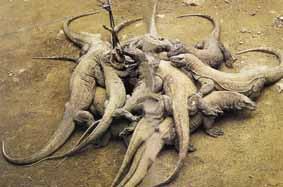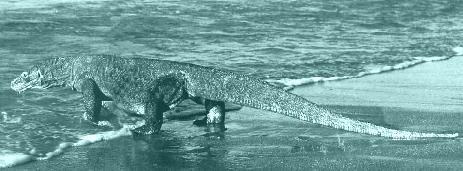




The dragon beyond myths |
Contents
|
The author, Dr. Eric Wickramanayake, Senior Fellow, World Wildlife Fund, is a Research Assistant/ Visiting Scientist for the National Zoological Park, Smithsonian Institution. At the time of writing this story he was co-principal investigator of the project to study the demographics and ecology of the Komodo dragon in Indonesia.
Dr. Wickremanayake, an old boy of S Thomas' College, Mt. Lavinia, got his Ph.D in Ecology from the University of California, Davis.
He is currently in Cambodia as part of an effort to develop a conservation management plan at their Virachey National Park.
It looked like something straight out of Jurassic Park. The setting was a beach at the edge of Slawi Bay on the island of Komodo in central Indonesia. The action took place a mere 20 yards or so from where I stood. A giant lizard had attacked a large mammal, driving it into thesurf and slashing the tendons of its hind legs. Now it was moving in for the kill. Eons have passed since the Age of the Dinosaurs, when enormous reptiles were the hunters and mammals the hunted, but this was no Hollywood reenactment. The "monster" was a Komodo dragon, its victim a Sunda deer.
 The
dragon is the largest lizard in the world. It can grow to a length of nine feet
or more and weigh as much as 200 pounds, after a good meal. With its serrated
teeth, powerful claws and surprising quickness, it is a formidable predator. The
origin of its fabulous name is unclear, though it owes much to human
imagination. It could be that the first people who saw the impressive reptiles —
perhaps Chinese fishermen hundreds of years ago — called them dragons
because of their size and the yellow forked tongues that shoot out of their
mouths like flames. Certainly early Westerners in the area, greatly exaggerating
the dragons' size and power, used and gave credence to the name.
The
dragon is the largest lizard in the world. It can grow to a length of nine feet
or more and weigh as much as 200 pounds, after a good meal. With its serrated
teeth, powerful claws and surprising quickness, it is a formidable predator. The
origin of its fabulous name is unclear, though it owes much to human
imagination. It could be that the first people who saw the impressive reptiles —
perhaps Chinese fishermen hundreds of years ago — called them dragons
because of their size and the yellow forked tongues that shoot out of their
mouths like flames. Certainly early Westerners in the area, greatly exaggerating
the dragons' size and power, used and gave credence to the name.
The Smithsonian's National Zoological Park (NZP) sent me to Komodo to study the dragons' ecology and find out what makes them tick. The project was conceived several years before I came on board, when Dale Marcellini, then the curator of herpetology at the NZP, visited the island in 1988 to accept a pair of dragons as a gift from the Indonesian government. While he was there, Marcellini saw a lot of adult dragons but few juveniles. That raised a red flag. If young ones were not growing up and breeding, the entire population could crash. One of my objectives was to assess that situation. Another was to find out what it is about the hardy dragons that has enabled them to survive in an environment that apparently is inhospitable to big cats and other mammalian predators.
Komodo is one of only four small islands on which dragons live. The others are nearby Rinca, Gili Motang and Flores. All are part of the island chain, just east of Java and Bali, called the Lesser Sundas. You can pick out Flores in an atlas but could be hard put to find the other three, unless you look closely between Flores and Sumbawa. Even this limited range has begun to shrink; whereas dragons could once be found throughout the western and northwestern coasts of Flores, the largest island, they are now confined to isolated populations there. Until recently, they also inhabited Padar, a small island tucked midway between Komodo and Rinca. Although it is not what I would call a tropical paradise, Komodo does have gorgeous white-sand beaches.
The interior landscape consists of grassy hills, steep mountains and dry savannas. The heat is stifling, but this does not deter thousands of tourists from visiting the remote island each year. One of the entertainments that used to divert them was a biweekly offering of goats and chickens (dead and alive) to a throng of dragons, which proceeded to tear the animals to bits while the visitors snapped pictures. The grisly event was scrapped some time ago. It wasn't until the beginning of this century that the dragons became known to science. After hearing rumors about 20-foot-long "land crocodiles," a Dutch civil servant (Indonesia was controlled by the Dutch until 1949) found and killed a dragon on Komodo. The skin was sent to a museum in Buitenzorg (now called Bogor) on the island of Java, where the animal was scientifically described and named Varanus komodoensis. Soon thereafter, colonial and native rulers of the area made it illegal to hunt or capture dragons without permission. In 1928, Komodo was officially proclaimed a wilderness area, one of the first in Asia. Today the dragon is classified as an endangered species in part because its range is so small — the smallest of any large carnivore in the world. Indonesia has protected this critical habitat by designating most of it a national park, and the dragon itself is revered as a national treasure.
At present there are an estimated 3,000 to 5,000 dragons at large in the wild and more than 200 living in captivity. Since 1982, captive breeding programs have augmented the world's dragon population by 157. The Smithsonian operates one such program, which was initiated with the animals Marcellini brought back from Indonesia.
Dragons have been bred in captivity in three Indonesian zoos, and other zoos around the world are interested in developing programs of their own. Not surprisingly, dragons have been the subject of much mythmaking, and tales of man-eaters are common. My own experience on Komodo, as well as that of other researchers there before me, leads me to believe that the creatures are unlikely to attack humans.
Nevertheless, there are perhaps a dozen more or less reliable accounts of people being killed or eaten by dragons.
One of them describes how a woman engaged in a desperate tug-of-war with a dragon when she tried to pull her child from its clutches; the dragon won.
Perhaps the best-known incident involved a Swiss baron, Rudolf von Reding Biberegg, by name, who went for a hike one day in 1974 with several friends. At one point the baron, who was 78, sat down to rest, waving the others on. He was never seen again. His companions launched a search and found only his camera. Naturally, dragons were blamed for his death.
Whether the baron really was killed by dragons will probably never be known. The possibility can't be ruled out. Another scenario, perhaps more likely, is that one or more of the creatures happened upon the poor man's body after he died or was seriously disabled by a stroke or accident.
Although dragons might occasionally be tempted to make a meal of a small child or sleeping adult, humans clearly are not a main item on their menu. Walter Auffenberg, a zoologist from the University of Florida who spent over a year on Komodo, Padar and Flores studying dragons, observed that they eat poisonous snakes, birds, small mammals, deer, pigs, water buffalo — and other dragons. They are also known to be scavengers and can be seen lumbering along the beaches looking for dead fish and other carrion.
How do they kill large prey? lt's generally believed that, camouflaged in the brush, they lie in wait along game trails until a pig or deer wanders by, at which point they rush it and bring it down or, more likely, wound it so badly it dies soon thereafter. In that case, death may result from loss of blood or from infection caused by the bacteria contained in the dragon's saliva. While ambush is a common tactic, dragons are active hunters, too. I was out in a woodland one day when I saw a small one, maybe 1 or 2 years old, scampering across the landscape with an adult in hot pursuit. The small dragon made a wide half-circle, which put it on a course heading directly toward me. It then scrambled up a large tamarind tree about 30 feet away, barely escaping the jaws of the adult. The large dragon, unable to climb after the smaller one because of its considerable bulk, stopped short, looked up in the tree for a moment and then ambled away.
I witnessed other instances of active perdition. For example, I saw dragons digging for eggs in the mound nests made by orange-footed megapodes, chicken-size birds found in southeastern Indonesia and Australia. The nests, which can measure more than 20 feet in diameter and about three feet in height, consist of sand and dead and decomposing sticks and leaves. The heat produced by the composting vegetation incubates the eggs. The birds tend the nest by moving and kicking the nest material with their feet to make sure a proper temperature is maintained.
Unlike orange-footed megapodes, dragons don't tend to the eggs in their own "nests," which usually are burrows dug into hillsides or dry stream banks. However, some females appear to stand guard for a short time after their eggs are laid — and there is good reason to do so. Among the potential raiders they have to fear are other dragons intent on digging up the eggs or eating the young as they emerge from the burrows.
There isn't much good information on when dragons become sexually mature — an ironic testimony to how little we know about the world's largest lizard. They probably start reproducing when they're 5 to 7 years old. The animals mate during the middle of the dry season, which extends from May through November. The female lays from 15 to 30 eggs, which incubate in their burrow throughout the wet season (from late December to April) and hatch soon thereafter.
The newly hatched dragons head for the trees and stay in them until they are about four feet long. They feed on insects and small lizards and, for safety's sake, make only occasional forays onto the ground. The beautiful orange, yellow, black and white markings of the hatchlings make them cryptic; they are extremely hard to spot until you figure out where to look for them and gradually develop a search image. This is the reason Dale Marcellini failed to see many juveniles during his brief visit.
I found my first hatchling by following tracks in the sand that led to a tree. I inspected the tree carefully and spotted the baby dragon, still displaying an umbilical scar, clinging to a branch. If it weren't for the fact that I'd had prior experience searching for lizard hatchlings in Asia, I might have missed it. After that, I spent a lot of time looking up into trees, and I did see many baby dragons. I also set out baits that attracted several juvenile animals, which appeared to be 1 to 3 years old. This was further evidence that the dragons were reproducing and that the young were growing up to become part of the adult population.
The ancestry of the Komodo dragon dates back to the Miocene, about 15 million years ago. For a long time, experts differed about where the genus Varanus originated. Of the 40 or so species in the genus, commonly known as monitor lizards, about 30 live in Australia. That led early researchers to conclude that monitor lizards originated in Australia and subsequently moved across numerous sea straits, island-hopping westward into Asia and Africa. But the German herpetologist Robert Mertens argued that the genus probably originated in the Indo-Australian archipelago, of which the Lesser Sundas are a part. Chromosomal analysis has supported Mertens' contention. Furthermore, geologic evidence points to the likelihood of a collision between the archipelago and the Australian landmass after Varanus evolved, which could account for the genus's present distribution.
The dragon was by no means the only large reptile on the loose in those times. Huge crocodiles, tortoises and snakes roamed the Pleistocene landscape, as did the 20-foot-long, 1,300-pound giant monitor lizard Megalania prisca in Australia. But the reign of the giant reptiles had drawn to a close. Mammals, which until the extinction of the dinosaurs were small creatures cowering in the undergrowth, had already made their evolutionary move. Enormous saber-toothed cats, bears and lions were the top terrestrial predators everywhere, except on those several islands in the Lesser Sundas where the Komodo dragon continued to reign supreme and where, except for humans, it still does.
No one knows how dragons have been able to thrive in an environment where mammalian predators apparently never gained a toehold. Some scientists have theorized that the prey base could be too small to support mammalian carnivores but is adequate for dragons, which don't need as much to eat.

Continue to Plus page 2 - Pearls: the subject of the art






Please send your comments and suggestions on this web site to
info@suntimes.is.lk or to
webmaster@infolabs.is.lk